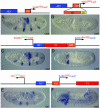Long-range enhancer-promoter interactions in the Scr-Antp interval of the Drosophila Antennapedia complex
- PMID: 12909726
- PMCID: PMC187872
- DOI: 10.1073/pnas.1233791100
Long-range enhancer-promoter interactions in the Scr-Antp interval of the Drosophila Antennapedia complex
Abstract
Long-range enhancer-promoter interactions are commonly seen in complex genetic loci such as Hox genes and globin genes. In the case of the Drosophila Antennapedia complex, the T1 enhancer bypasses the neighboring ftz gene and interacts with the distant Scr promoter to activate expression in posterior head segments. Previous studies identified a 450-bp promoter-proximal sequence, the tethering element, which is essential for T1-Scr interactions. To obtain a more comprehensive view of how individual enhancers selectively interact with appropriate target genes, we used bioinformatic methods to identify new cis-regulatory DNAs in the approximately 50-kb Scr-Antp interval. Three previously uncharacterized regulatory elements were identified: a distal T1 tethering sequence mapping >40 kb from the proximal tethering sequence, a repressor element that excludes activation of Scr by inappropriate enhancers, and a new ftz enhancer that directs expression within the limits of stripes 1 and 5. Many of the regulatory DNAs in the Scr-Antp interval are transcribed, including the proximal and distal tethering elements. We suggest that homotypic interactions between the tethering elements stabilize long-range T1-Scr interactions during development.
Figures





References
Publication types
MeSH terms
Substances
Grants and funding
LinkOut - more resources
Full Text Sources
Molecular Biology Databases

